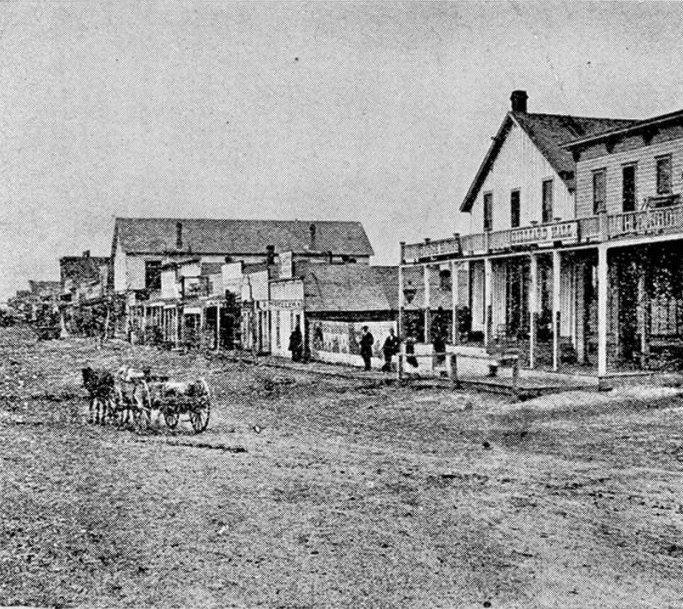Dodge City Boot Maker and Cattleman

John Mueller (aka, Müller) was born in 1840 in Bavaria, Germany. coming to the United States in 1855. He married Karoline Koch in St. Louis early in 1862. He was already enlisted in the Union Army–serving from 1861 to 1865–and was wounded two-times.
Karoline Koch was born in Berweiler, Germany (Alsace-Lorraine). She came to the United States with her parents in 1850, through the port of New Orleans and settled in St. Louis, Missouri. John and Karoline had eight children, but only two survived–Emelia and Henry.
In St. Louis, John was a neighbor of the Anheuser, Busch and Lammerts families, and was said to have been invited into the brewery business by Anheuser. Mueller reported said, “No, you’ll never make money selling 5-cent beer.” Anheuser said, “Then I’ll serve lunch with it.”
The Muellers moved to Kansas City in 1869 and to Great Bend, Kansas, in 1870, then to Abilene in 1872. John followed the cattle trail to make boots for cowboys and frontier men, such as Wild Bill Hickok, Buffalo Bill, and others.
John and Karoline moved to Ellsworth, Kansas, in 1873 and Henry was born there in 1874. The same year the family moved to Dodge City. They lived at Fort Dodge for several years.
When John Mueller arrived in Dodge City in 1875, he had left a successful business in Ellsworth, Kansas. In November 1875, he bought Lot 10 Block 2 on Front Street from Robert Wright for $650, where he located his boot and shoe shop. It was west of the Dodge House hotel and across the street from the railroad water tank and depot.
Front Street, Dodge City, c.1879, looking west from Atchison, Topeka and Santa Fe train depot. John Mueller’s boot shop, with black boot in front, is third building from right (on land purchased by Mueller on November 11, 1875, from Robert M. Wright). Mueller sold it on September 13, 1881. Cox and Boyd’s famous Dodge House Hotel is second building from right. All rights reserved, FCHS.

He became very successful and in 1877, he and Walter Straeter became partners, merging their two boot and shoe shops. It was a first-class business where they “gave perfect fits, performed excellent work and used nothing but the best material.” Their business kept a half-dozen workmen busy. Straeter superintended the shop while Mueller did the cutting and “figure work.” They carried the largest stock of shop-made boots in the city, selling from $8 to $18 a pair.
In January 1878, John Mueller and Walter Straeter rented A.B. Webster’s corner, billed as the best location in the city, and made plans to open a saloon. March 9, 1878, was the grand opening of the “Old House” saloon. It was one of the largest and finest in the city and soon housed one of the finest billiard tables. Straeter presided at the Old House saloon, while Mueller continued in the boot business. Both businesses were highly successful.
In 1879, John Mueller began plans for his home to be erected northwest of the Ford County Court House, which was out in the country as far as the rest of Dodge City was concerned. It took 18 months to complete. The house was built of gray limestone quarried from the Sawlog Creek, 12 miles northeast of Dodge City. The rocks were two feet thick, even the ones used for the partitions.
In September 1881, the stone home was ready for occupancy and the Mueller family took up residence. October 30, a surprise housewarming party was held for the Muellers. Chalk Beeson and his orchestra played and several danced in the empty parlor.
Emelia Louise Mueller, daughter of John and Karoline, was married in the family home on June 12, 1889, to John Hageman Chambliss, stepson of buffalo hunter A.J. Anthony. The wedding was a great event and was reported in the Dodge City Times on June 13, 1889, under “Wedding Bells.”
The cattle season of 1880 was such a success that many Dodge City merchants decided to venture into the cattle business. John Mueller was one of those cattle entrepreneurs, along with Chalk Beeson and Jacob Collar. In September 1881, John Mueller decided to devote his full-time and attention to the cattle business. He sold his shoe and boot business to Oscar Trevallen who recently had returned from Caldwell, Kansas.
The cattle brand used by John Mueller was a “boot”. By 1886, Mueller had three ranch herds. The first was on Five Mile Hollow and the Sawlog Creek; the second on Crooked Creek, south of Dodge City, near Meade Center; and the third on the Smoky Hill River, north about 95 miles in Lane and Scott Counties. The day before the great blizzard of January 1886, he was offered $75,000 for one of his herds but he chose not to sell. The blizzard that began the next day wiped out all three of his herds.
Following the blizzard, Mueller was broke and returned to the shoe and boot business. A warranty deed, dated February 20, 1886, shows that John Mueller “sold” his house to his wife, Karoline Mueller, for $4,000. By 1890, he became convinced that the new farm population did not have use for his custom-made cowboy boots.
A warranty deed dated March 4, 1890, shows that Karoline Mueller sold the “home of stone” to Elizabeth Schmidt, wife of Adam Schmidt, the local blacksmith, for $5,000. John and Karoline and son Henry moved back to St. Louis. John went back into the US Army, but due to an accident died within two years. Henry Mueller would visit the house until the 1950s.
